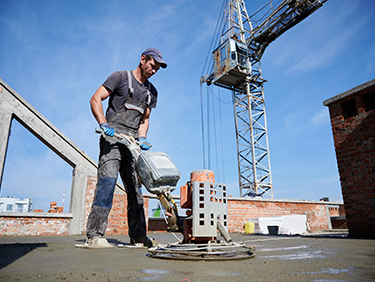In a recent report, HC Brokerage shed the light on the cement industry in Egypt, specifically on Arabian Cement Company (ARCC) where they cut our 2022–25e EBITDA estimates by c12%.
-
The market is still digesting new macroeconomic and industry developments, which entails prudent pricing and cost management
-
Despite lowering our gross margin estimates, reflecting inflationary pressures, we expect ARCC to maintain its cost advantage
-
We cut our 2022–25e EBITDA estimates by c12%
Nesrine Mamdouh, Analyst of Industrials at HC commented that: “ Market supply/demand imbalance pressures local prices: While the Egyptian government’s introduced quota system in July 2021 curtailed local sales to 51–52m tpa, the increases in effective quota for 2022 left the effective total market capacity at around 56m tpa, 8.3% higher than the original 2021 quota. Our estimates reflect the Egyptian Competition Authority (ECA)’s July 2022 decision to increase the local cement sales quota by 8.0% and allow cement companies to exceed their quotas in certain months to regulate supply and demand. In 2022, local cement sales increased by c5% y-o-y to 51.2m tons, with the market achieving 91.4% of the quota while ARCC achieved 96.5% of its quota, demonstrating its above-average ability to take advantage of quota increases. For 2023e, if cement companies pass through the higher costs onto their customers, the retail selling price will increase to as much as EGP2,100-2,140/ton, negatively affecting demand. Therefore, we expect companies to absorb part of the increase in costs and forecast 2023e local cement prices at a range of EGP2,042-2,068/ton, moderately pressuring their margins depending on each company’s cost structure and exposure to export markets. We project local demand in 2023 to grow by an average of c2-3%, down from 5.4% a year earlier, reflecting the slowdown in construction activity. Maintaining the 2023 quota without occasional monthly increases will improve cement companies’ pricing power. Over 2023e–26e, we estimate local cement demand to increase by an average of c2.3% y-o-y and to grow at a CAGR of 2.27%. A recovery in private sector investments and any potential upcoming government decisions on private building permits are key upside risks to our numbers. As for ARCC, we expect local sales to increase by 2.1% y-o-y in 2023e to 3.29m tons, maintaining the 2023e quota. An occasional higher monthly quota would translate to an increase of up to c4% y-o-y in local sales. We forecast local sales to grow at a 2024e–26e CAGR of 2.51%.”
Nesrine Mamdouh added: “Exporting seems a more viable option for Egyptian cement players, especially following the recent EGP devaluation: Despite slimmer margins on cement and clinker exports historically, the EGP devaluation made exports more attractive and inflated the cash margins in EGP terms, improving the overall margins of exporting cement companies. In 2022, cement companies’ export volume increased c19% y-o-y to 9.56 m tons, and exports went mainly to Africa. Given an EGP devaluation of c37% in 2022, and c19% y-t-d. ARCC captured a significant share of 10.5% of 2022 exports, following military-owned factories with an export share of c67%, Suez Cement Group with c12%, and other sector players with 10.5%, topped by Lafarge. We expect ARCC to maintain its high export volume of around an average of 1m ton/year over our forecast period and foresee a potential further increase in export in 2023e in case of lower-than-expected local demand and/or lower-than-expected local price adjustment to devaluation. Exporting gives the company a comparative advantage in securing its FX needs, lowering fixed production costs on larger-scale production, and offering an attractive cash margin in EGP terms. Also, we expect ARCC to further benefit from the government’s export promotion program and expect a higher income from export rebates, as implied by the FY22/23 state budget.”
Nesrine Mamdouh concluded: “Inflationary pressures squeeze cement companies’ margins, yet we expect ARCC to maintain its cost advantage: In February 2022, Russia’s invasion of Ukraine led to supply chain disruptions, driving commodities into a price spiral. As a result, coal prices increased dramatically, reaching an all-time high in August 2022 of USD388/ton (CIF), an increase of 3.05x over January 2022 average prices. This was fueled by the European ban on Russian coal exports, effective August 2022, which later caused significant divergence and distortions in coal prices across regions. However, coal prices softened to USD142/ton as of 1 February 2023, after Europe had already heavily stockpiled coal as an alternative energy source to natural gas. Russia redirected its coal sales at very competitive prices to other non-sanction destinations, including China and India, which are also likely to boost their domestic production in 2023, according to S&P Global forecasts. Furthermore, on 9 October 2022, the Egyptian Cabinet more-than-doubled the natural gas price for cement producers to USD12.0/mmbtu from USD5.75/mmbtu. However, natural gas was partially used by a few cement players and fully by very few companies like South Valley Cement (SVCE EY) which increased its cash cost per ton. This will also alter the fuel mix of the cement companies that partially use natural gas in their fuel mix, leading them to rely more on cheaper options. Based on our calculations, coal prices above USD285/ton CIF should make companies indifferent between using coal or natural gas. On 27 October 2022, the Central Bank of Egypt (CBE) decided to raise the benchmark overnight deposit and lending rates by 200 bps to 13.25% and 14.25%. Also, it moved to a durably flexible exchange rate regime, leaving the forces of supply and demand to determine the value of the EGP against other foreign currencies. On 22 December, it raised the policy rates further by 300 bps, increasing cement companies’ working capital financing costs. The EGP devaluation of c19% since 27 October 2022 to date increased the cash cost per ton of cement players due to their coal imports and other foreign currency cost components of production. However, their exports will benefit from the EGP devaluation as they will become more competitive. Thus, we expect the devaluation to compress sector margins moderately in 2023e, holding all else constant, including export levels and cost structures. We expect coal and petcoke prices to normalize throughout our forecasting period, limiting sharp, abrupt increases in the cash cost per ton and alleviating the negative effect of EGP devaluation on margins. For ARCC, we are positive about its future performance and expect it to maintain its cost advantage due to: (1) its flexibility in changing its fuel mix to the most cost-effective one, 2) its effective raw material procurement and inventory management strategies, which proved to be successful, especially over the last two years, 3) its growing reliance on solar energy to cut costs, and (4) its remarkable export level, estimated at c23% of total sales in 2023e.”


